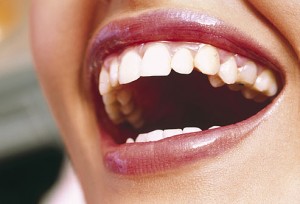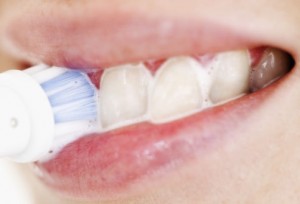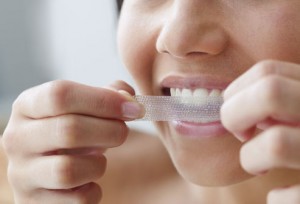
counter gels, rinses, strips, trays, and whitening products obtained from a dentist.
Teeth whitening is ideal for people who have healthy, unrestored teeth (no fillings) and gums. Individuals with yellow tones to their teeth respond best. But this cosmetic procedure is not recommended for everyone.
Find out if teeth whitening is right for you.
Whitening Systems
Whitening Toothpastes

Over-the-Counter Whitening Strips and Gels
Whitening gels are clear, peroxide-based gels applied with a small brush directly to the surface of your teeth. Instructions vary depending on the strength of the peroxide. Follow the directions on the product carefully. Initial results are seen in a few days and final results are sustained for about four months.
Whitening strips are very thin, virtually invisible strips that are coated with a peroxide-based whitening gel. The strips are applied twice daily for 30 minutes for 14 days. Initial results are seen in a few days and final results are sustained for about four months.
Whitening Rinses

Tray-Based Tooth Whiteners
Tray-based tooth whitening systems, purchased either over-the-counter or from a dentist, involve filling a mouth guard-like tray with a gel whitening solution — which contains a peroxide-bleaching agent. The tray is worn for a period of time, generally from a couple of hours a day to every day during the night for up to four weeks and even longer (depending on the degree of discoloration and desired level of whitening).
In-Office Whitening

How Long Do Whitening Effects Last?
Teeth whitening is not permanent. People who expose their teeth to foods and beverages that cause staining may see the whiteness start to fade in as little as one month. Those who avoid foods and beverages that stain may be able to wait one year or longer before another whitening treatment or touch-up is needed.
The degree of whiteness will vary from individual to individual depending on the condition of the teeth, the level of staining, and the type of bleaching system used.
At Home vs. Dentist Supervised
Do-it-yourself methods aren’t the same as getting your teeth whitened by a professional. You’ll want to consider a few important differences.
Strength of bleaching agent. Over-the-counter products and dentist-supervised at-home products usually contain a lower strength bleaching agent, with about a 10% to 22% carbamide peroxide content, which is equivalent to about 3% hydrogen peroxide. In-office, professionally applied tooth whitening products contain hydrogen peroxide in concentrations ranging from 15% to 43%.

Over-the-counter whitening products also contain a mouthpiece tray, but the “one-size-fits-all” approach means that the fit will not be exact. Ill-fitting trays can irritate the gum and soft tissue by allowing more bleaching gel to seep onto these tissues. With in-office procedures, you’ll get the bleaching agent applied directly to your teeth.
Additional protective measures. In the office setting, your dentist will apply either a gel to the gum tissue or use a rubber shield (which slides over the teeth) prior to treatment to protect your gums and oral cavities from the effects of the bleaching. Over-the-counter products don’t provide these extra protective measures.
Costs. Over-the-counter bleaching systems are the least expensive option, with in-office whitening being the costliest.
Supervised vs. unsupervised process. First, your dentist can perform an oral exam and consider your complete medical history, which can be helpful in determining if bleaching is an appropriate course of treatment based on the type and extent of stains, and the number and location of restorations. Your dentist can then better match the type of stain with the best treatment, if appropriate, to lighten those stains.
When your dentist does it, he’ll likely want to see you a couple of times to clear up any questions about the directions, to make sure the customized tray fits properly, to check your gums for signs of irritation, and to generally see how the process is working. With over-the-counter bleaching products, you’re on your own.
Should You Whiten Your Teeth?
Whitening is not recommended or will be less successful in the following circumstances:

Sensitive teeth and allergies. Individuals with sensitive teeth and gums, receding gums, and/or defective restorations should consult with their dentist prior to using a tooth-whitening system. Anyone allergic to peroxide (the whitening agent) should not use a bleaching product.
Gum disease, worn enamel, cavities, and exposed roots. Individuals with gum disease or teeth with worn enamel are generally discouraged from undergoing a tooth-whitening procedure. Cavities need to be treated before undergoing any whitening procedure. This is because the whitening solutions penetrate into any existing decay and the inner areas of the tooth, which can cause sensitivity. Also, whitening procedures will not work on exposed tooth roots, because roots do not have an enamel layer.
Fillings, crowns, and other restorations. Tooth-colored fillings and resin composite materials used in dental restorations (crowns, veneers, bonding, bridges) do not whiten. Therefore, using a whitening agent on teeth that contain restorations will result in uneven whitening — in this case, making the teeth without restorations appear lighter than those with restorations. Any whitening procedure should be done prior to the placement of restorations.
People with numerous restorations that would result in uneven whitening may be better off considering bonding, veneers, or crowns rather than a tooth whitening system. Ask your dentist what strategy is best for you.
Unrealistic expectations. Individuals who expect their teeth to be a new “blinding white” may be disappointed with their results. Smokers need to be aware that their results will be limited unless they refrain from continued smoking, particularly during the bleaching process. A healthy guide to is to achieve a shade slightly whiter than the whites of your eyes.

Teeth that have dark stains may be better candidates for another lightening option, such as veneers, bonding, or crowns. Your dentist can discuss the options best suited for you.
Risks Associated With Whitening
The two side effects that occur most often with teeth whitening are a temporary increase in tooth sensitivity and mild irritation of the soft tissues of the mouth, particularly the gums. Tooth sensitivity often occurs during early stages of the bleaching treatment. Tissue irritation most commonly results from an ill-fitting mouthpiece tray rather than the tooth-bleaching agent. Both of these conditions usually are temporary and disappear within 1 to 3 days of stopping or completing treatment.
If you do experience sensitivity, you can reduce or eliminate it by:
- Wearing the tray for a shorter period of time (for example, two 30-minute sessions vs. two 60-minute sessions).
- Stop whitening your teeth for 2 to 3 days to allow teeth to adjust to the process.
- Ask your dentist or pharmacist for a high fluoride-containing product, which can help remineralize your teeth. Apply the fluoride product to the tray and wear for 4 minutes prior to and following the whitening agent.
- Brush teeth with a toothpaste made for sensitive teeth. These toothpastes contain potassium nitrate, which helps soothe the teeth’s nerve endings.
Whitening Product Safety
Some whitening products you get through dentists’ offices as well as professionally applied (in-office) bleaching products have the American Dental Association (ADA) Seal of Acceptance, which tells you that the product meets ADA guidelines for safety and effectiveness. Currently, only dentist-dispensed home-use products containing 10% carbamide peroxide and office-applied products containing 35% hydrogen peroxide have this seal.
Over-the-counter bleaching products are not endorsed by the ADA, because the organization believes that professional consultation is important to ensuring safe and effective use. No whitening products using lasers are on the ADA’s list of accepted products.
Teeth whiteners are not drugs and therefore aren’t regulated by the FDA.
Choosing an Over-the-Counter Whitening Kit
Try to select a product that allows the mouthpiece to be customized. Some kits come with a tray that can be molded to some degree. These are better than others that come with a standard mouthpiece.
Look for online reviews and ask around to find out what others who may have already tried the kit you’re considering think about it.
If at any time you experience a prolonged change in the color of your gums or an increased tooth sensitivity to hot or cold foods and beverages, stop wearing the mouthpiece and see your dentist immediately.
Several whitening toothpastes available in drugstores have received the seal, too. You can find a list at www.ada.org.
Not all manufacturers seek the ADA’s Seal of Acceptance. This is a voluntary program that requires considerable expense and time on the part of a manufacturer. Just because a product doesn’t have the seal does not necessarily mean that the product isn’t safe and effective.
